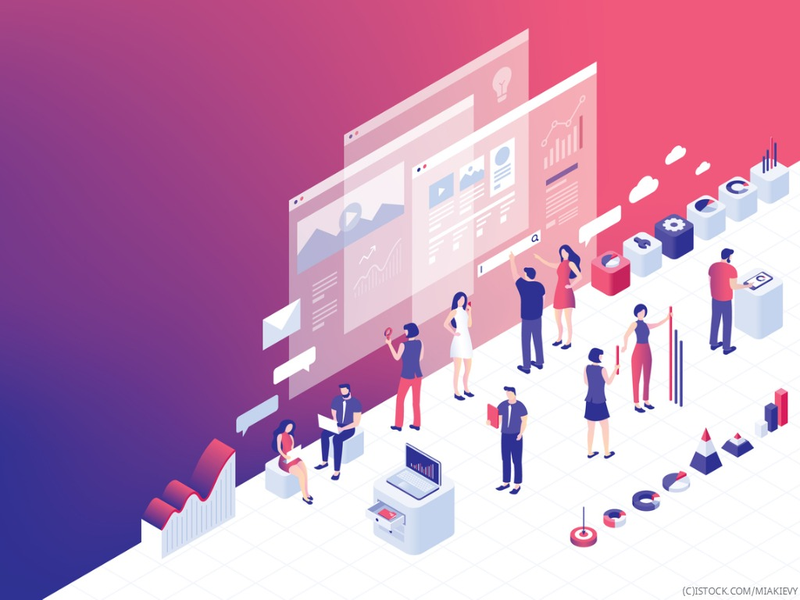
There is no doubt that the global Covid-19 pandemic has accelerated digital adoption. For many companies, this move was one they were, understandably, unprepared for. And even for some of those businesses who were already operating online, their technology was either not sufficient enough to adapt at speed, or too general to meet the rapidly changing needs of their customers.
Even post-pandemic, consumer needs are continually evolving, with people shopping on mobile devices, on social networks, and in online marketplaces, even through IoT (Internet of Things) devices. Now more than ever, brands need to offer a true omnichannel experience to reach their audience across all of these platforms, connecting all consumer touchpoints seamlessly.
The demand for a more agile and personalised approach has seen marketers turn towards MACH architecture which allows for speed, scalability and flexibility. By bringing together a set of connected digital services that can run independently from each other.
Not only does this allow companies to make business decisions quicker, it allows for greater innovation to offer a more customer-centric experience. In a competitive marketplace, being innovative and delighting customers with a unique and compelling digital experience can make or break an eCommerce business.
MACH – what is it made up of?
MACH is an acronym for Microservices; API-first; Cloud-native; and Headless – a modern, composable software strategy defined by working with smaller solutions that seamlessly integrate with one another. It is this ‘composable’ architecture which allows for a modular approach meaning every component is pluggable, scalable, replaceable, and can be continuously improved.
Traditionally, eCommerce businesses only had the option of monolithic architecture, which by definition means ‘composed all in one piece’. So any required software developments or updates needed to be done to the whole system, rather than the individual elements – a lengthy and inefficient process. This also meant pivoting the business or scaling at speed would be difficult to achieve.
But the growth of eCommerce, particularly over the last year, has shown that businesses need to adapt – and fast. With monolithic platforms often slow and with many limitations, businesses need a more agile approach to stay ahead of their competitors and offer a more fulfilling digital customer experience.
Microservices
Microservices are specific functions that can be developed, deployed and managed independently from each other, resulting in faster updates and quicker access to new features. For eCommerce, functionalities such as the shopping cart or product page each have their own code which can be independently scaled, as opposed to scaling the entire application. This flexibility also permits for greater customisation – allowing new features to be developed and tested to see what works best for customers.
API-first
APIs are what allow communication between programs – linking your frontend and backend communications to power your eCommerce business. APIs enable flexibility to think beyond the limits of any one platform or technology – seamlessly connecting systems in a more modular fashion. They allow companies to connect to different frontend experiences from a single backend, beyond the limits of any one platform or technology, offering a truly omnichannel experience.
Cloud-native
A cloud-native application is one that is built specifically for, and operated within, the cloud environment, providing quicker wide-scaling capabilities, both vertical and horizontal, beyond storage and hosting.
For eCommerce, the shopping cart functionality can be scaled as a single piece of software benefitting from unlimited data storage capabilities, meaning it is capable of dealing with a sudden influx of sales, such as the Black Friday sales.
Through built-in monitoring, functionality and infrastructure updates are automatically applied, with the benefit of no downtime which can impact upon the customer experience or lead to loss of sales.
Headless commerce
Headless commerce refers to the decoupling of the front end and back end, so it’s possible to change either the content presentation layer or business functional (commerce) layer without touching the other.
Where traditional monolith architecture is governed by a rigid template where ideas need to be adapted to fit, headless allows for greater flexibility in frontend design to deliver a better UX experience – independently from the backend interface.
This decoupling of the front end and back end allows companies to differentiate themselves from their competitors – bringing creative freedom to the technology ecosystem. Essentially it’s the difference between the neatly laid out aisles of your generic big brand supermarket versus an innovative personalised experience – it’s clear which one will deliver the best customer experience.
Why MACH should be part of your marketing strategy
For marketers, following MACH principles allows for collaboration, testing, learning and agility – all of which can be done at speed. It is this flexibility and scalability which really comes into its own – particularly for brand customisation and customer experience improvement.
But for MACH to be adopted successfully, it’s important every business answers the following questions first:
- Does the business have the digital maturity to implement MACH?
- Do we operate a product led or project led approach?
- Are we prepared to take risks and experiment to deliver customer value?
- Is technology a priority for the business?
- Is there a hunger for innovation?
With strategic technology trends for 2021 focused on the ‘total experience’, according to Gartner, MACH offers a solution for businesses looking to ramp up their digital offering to meet ever evolving customer needs.

Interested in hearing leading global brands discuss subjects like this in person?
Find out more about Digital Marketing World Forum (#DMWF) Europe, London, North America, and Singapore.






